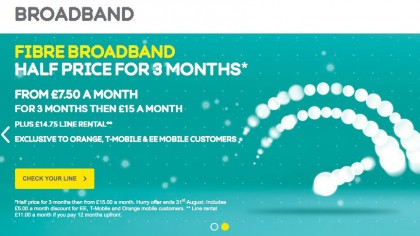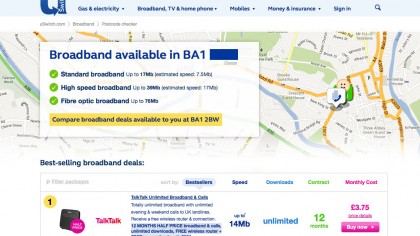BT Infinity and more: fibre broadband explained
Faster broadband: what it costs and when you can get it

Virgin too uses FTTC in most places. But it has some FTTP trials in addition to some bespoke business installations. Instead of using the old copper wires for the 'last mile' connection between the junction box and your home, Virgin uses its existing high-grade coaxial cable network, which can pipe data faster than copper wiring and with very little signal loss.
Many more ISPs use the growing fibre infrastructure to offer competing services. These include Sky Fibre, Plusnet, Talk Talk, EE and John Lewis.
Sky became the UK's second biggest ISP (having purchased O2 and BE's consumer broadband and fixed-line telephone service back in March).
How fast is fibre broadband?
Hop onto a comparison website such as uSwitch and you'll find fibre broadband packages that offer connections ranging from 30Mbps up to 120Mbps. BT Infinity packages have a top speed of 76Mbps, while Virgin's fibre connections peak at blistering speeds of 100-120Mbps. Let's put that in perspective. As Virgin Media website points out, 100Mbps can download:
- A 60MB music album in 6 seconds
- A 350MB TV show in 30 seconds
- A 1GB movie in 1.5 minutes
- A 4GB HD movie in 6 minutes
Of course, you might not get these top-end speeds. BT Infinity maxes out at 62.5Mbps in the area where we tested it, while the estimated ADSL broadband speed is a lowly 5.5Mbps. These ratings drop further during peak periods - especially 8pm to 10pm on weekdays.

The wide availability of superfast fibre connections have been directly responsible for a significant jump in the UK's average broadband speed. Ofcom reported that in 2008 the average as a lowly 3.6Mbps. Five years on, the average speed has risen to 14.7Mbps.
Fibre broadband also delivers speeds that are much closer to the advertised maximum speed. According to the same May 2013 Ofcom report, the average speed of an 'up to' 10Mbps cable connection in the UK was 9.3Mbps. Compare this to the speed of an 'up to 8Mbps' ADSL connection, which averaged only 3.3Mbps.
Are you a pro? Subscribe to our newsletter
Sign up to the TechRadar Pro newsletter to get all the top news, opinion, features and guidance your business needs to succeed!
How can I get fibre broadband?
Between them, BT and Virgin provide fibre optic broadband connectivity to over 15 million UK homes, and this will increase as work on the two networks continues. BT Openreach predicts 66% coverage by 2015.
In the meantime, it's easy to check whether you can get fibre optic broadband where you live. Most providers have their own postcode checkers, but you can simplify the process using an independent one such as SamKnows, Cable and uSwitch. Just enter your postcode and phone number and you'll get a handy list of the services available in your area.
How do I choose the best fibre broadband?
Fibre broadband providers are fighting for customers. But it's not all about paying the lowest price or getting a free wireless router. Some services offer unlimited downloads, while others are throttled by a usage cap.
There are other incentives - BT Infinity typically adds free weekend calls and access to its new BT Sport channels, while Virgin has triple-play cable TV, phone and broadband bundles, and EE throws in 2-for-1 cinema tickets every Wednesday.

Of course, if you live in a more rural area, you might not have access to fibre broadband at all. BT Openreach claims that the cost of upgrading the network in areas with only a relatively small number of people will generally be too high. But there could be an alternative.
In the future, the current FTTC and FTTH infrastructure could be joined by FTTA (Fibre To The Antenna), which works by multiplexing wireless signals and aggregating them into a single fibre-like 'air interface'. Until then, ADSL broadband will have to suffice.
- In a broadband no-go area? Check out Satellite broadband: can it light up the UK's broadband blackspots?